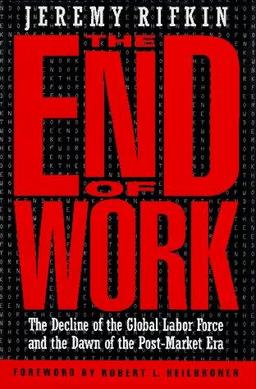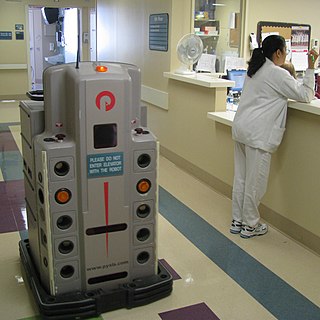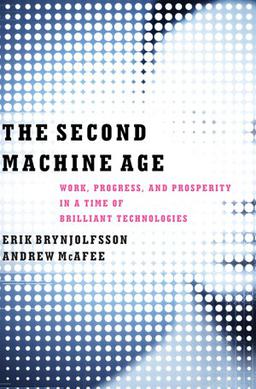
Automation describes a wide range of technologies that reduce human intervention in processes, mainly by predetermining decision criteria, subprocess relationships, and related actions, as well as embodying those predeterminations in machines. Automation has been achieved by various means including mechanical, hydraulic, pneumatic, electrical, electronic devices, and computers, usually in combination. Complicated systems, such as modern factories, airplanes, and ships typically use combinations of all of these techniques. The benefit of automation includes labor savings, reducing waste, savings in electricity costs, savings in material costs, and improvements to quality, accuracy, and precision.

An AI takeover is an imagined scenario in which artificial intelligence (AI) emerges as the dominant form of intelligence on Earth and computer programs or robots effectively take control of the planet away from the human species, which relies on human intelligence. Possible scenarios include replacement of the entire human workforce due to automation, takeover by an artificial superintelligence (ASI), and the notion of a robot uprising. Stories of AI takeovers have been popular throughout science fiction, but recent advancements have made the threat more real. Some public figures, such as Stephen Hawking and Elon Musk, have advocated research into precautionary measures to ensure future superintelligent machines remain under human control.
The productivity paradox refers to the slowdown in productivity growth in the United States in the 1970s and 1980s despite rapid development in the field of information technology (IT) over the same period. The term was coined by Erik Brynjolfsson in a 1993 paper inspired by a quip by Nobel Laureate Robert Solow "You can see the computer age everywhere but in the productivity statistics." For this reason, it is also sometimes also referred to as the Solow paradox.

Erik Brynjolfsson is an American academic, author and inventor. He is the Jerry Yang and Akiko Yamazaki Professor and a Senior Fellow at Stanford University where he directs the Digital Economy Lab at the Stanford Institute for Human-Centered AI, with appointments at SIEPR, the Stanford Department of Economics and the Stanford Graduate School of Business. He is also a research associate at the National Bureau of Economic Research and a best-selling author of several books. From 1990 to 2020, he was a professor at MIT.
General-purpose technologies (GPTs) are technologies that can affect an entire economy. GPTs have the potential to drastically alter societies through their impact on pre-existing economic and social structures. The archetypal examples of GPTs are the steam engine, electricity, and information technology. Other examples include the railroad, interchangeable parts, electronics, material handling, mechanization, control theory (automation), the automobile, the computer, the Internet, medicine, and artificial intelligence, in particular generative pre-trained transformers.

In Raëlian literature, humanitarianism is a collection of economic ideas designed by Raël to complement geniocracy.
The 'MIT Center for Digital Business' is an industry-funded research center headquartered at the MIT Sloan School of Management.
The following outline is provided as an overview of and topical guide to automation:

The End of Work: The Decline of the Global Labor Force and the Dawn of the Post-Market Era is a non-fiction book by American economist Jeremy Rifkin, published in 1995 by Putnam Publishing Group.

A technological revolution is a period in which one or more technologies is replaced by another new technology in a short amount of time. It is a time of accelerated technological progress characterized by innovations whose rapid application and diffusion typically cause an abrupt change in society.

Technological unemployment is the loss of jobs caused by technological change. It is a key type of structural unemployment. Technological change typically includes the introduction of labour-saving "mechanical-muscle" machines or more efficient "mechanical-mind" processes (automation), and humans' role in these processes are minimized. Just as horses were gradually made obsolete as transport by the automobile and as labourer by the tractor, humans' jobs have also been affected throughout modern history. Historical examples include artisan weavers reduced to poverty after the introduction of mechanized looms. Thousands of man-years of work was performed in a matter of hours by the bombe codebreaking machine during World War II. A contemporary example of technological unemployment is the displacement of retail cashiers by self-service tills and cashierless stores.

"Fourth Industrial Revolution", "4IR", or "Industry 4.0", is a neologism describing rapid technological advancement in the 21st century. It follows the Third Industrial Revolution. The term was popularised in 2016 by Klaus Schwab, the World Economic Forum founder and executive chairman, who asserts that these developments represent a significant shift in industrial capitalism.

Andrew Paul McAfee is a principal research scientist at MIT and cofounder and codirector of the MIT Initiative on the Digital Economy at the MIT Sloan School of Management. He studies how digital technologies are changing the world.

Average Is Over: Powering America Beyond the Age of the Great Stagnation is a 2013 book by American economist Tyler Cowen laying out his vision for the future trajectory of the global economy. It is a sequel to Cowen's 2011 pamphlet The Great Stagnation, which argued that America had exhausted many of the low-hanging fruit that had powered its growth in the 19th and early 20th century.

The Second Machine Age: Work, Progress, and Prosperity in a Time of Brilliant Technologies is a 2014 book by Erik Brynjolfsson and Andrew McAfee that is a continuation of their book Race Against the Machine. They argue that the Second Machine Age involves the automation of a lot of cognitive tasks that make humans and software-driven machines substitutes, rather than complements. They contrast this with what they call the "First Machine Age", or Industrial Revolution, which helped make labor and machines complementary.
Robotic process automation (RPA) is a form of business process automation that is based on software robots (bots) or artificial intelligence (AI) agents. RPA should not be confused with artificial intelligence as it is based on automotive technology following a predefined workflow. It is sometimes referred to as software robotics.
Automated journalism, also known as algorithmic journalism or robot journalism, is a term that attempts to describe modern technological processes that have infiltrated the journalistic profession, such as news articles and videos generated by computer programs. There are four main fields of application for automated journalism, namely automated content production, Data Mining, news dissemination and content optimization. Through artificial intelligence (AI) software, stories are produced automatically by computers rather than human reporters. These programs interpret, organize, and present data in human-readable ways. Typically, the process involves an algorithm that scans large amounts of provided data, selects from an assortment of pre-programmed article structures, orders key points, and inserts details such as names, places, amounts, rankings, statistics, and other figures. The output can also be customized to fit a certain voice, tone, or style.

Polanyi's paradox, named in honour of the British-Hungarian philosopher Michael Polanyi, is the theory that human knowledge of how the world functions and of our own capability are, to a large extent, beyond our explicit understanding. The theory was articulated by Michael Polanyi in his book The Tacit Dimension in 1966, and economist David Autor gave it a name in his 2014 research paper "Polanyi's Paradox and the Shape of Employment Growth".

The impact of artificial intelligence on workers includes both applications to improve worker safety and health, and potential hazards that must be controlled.
The decoupling of median wages from productivity, sometimes known as the great decoupling, is the gap between the growth rate of median wages and the growth rate of GDP per person or productivity. Erik Brynjolfsson and Andrew McAfee highlighted this problem toward the end of the twentieth century and the beginning of the twenty-first century. This problem furthermore leads to wage stagnation for the median despite continued economic growth overall. Mathematically, if inequality grows, then top incomes and total income can increase even if median income is relatively stagnant.













